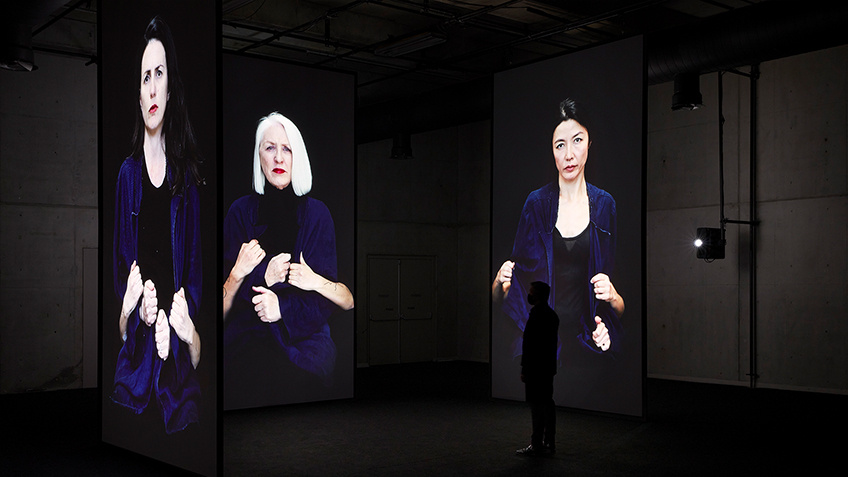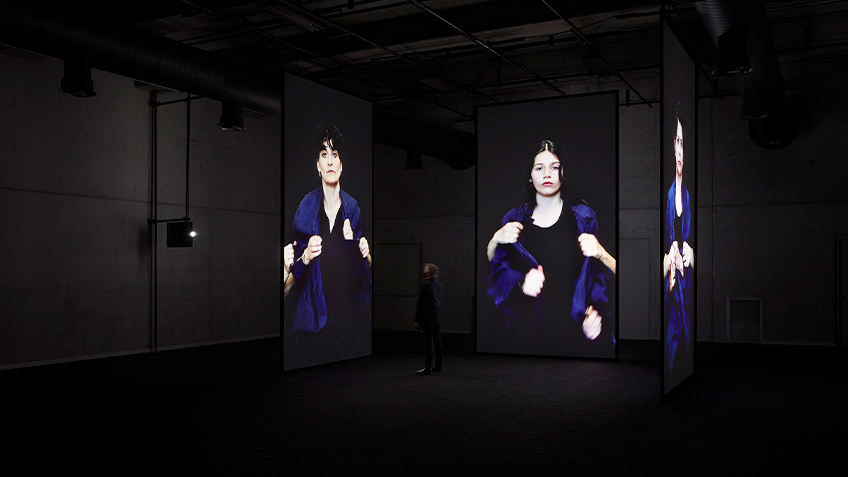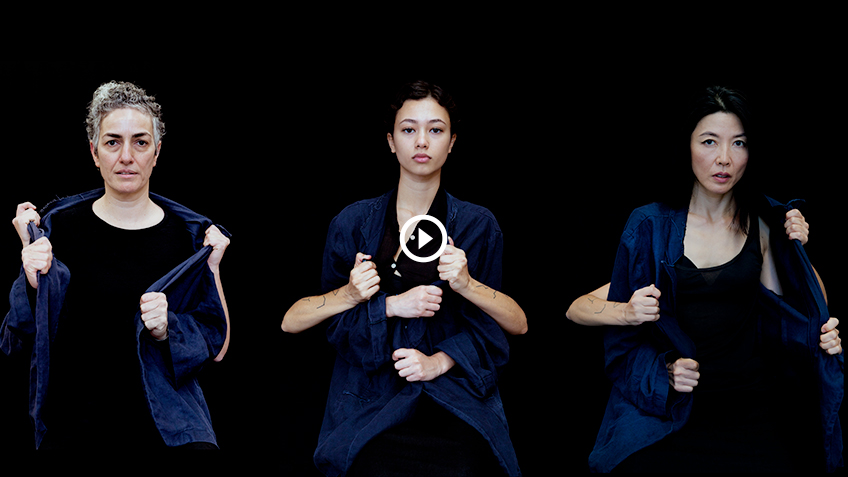Writer in residence Fiona Kelly McGregor on Cherine Fahd’s Ecdysis at Carriageworks until Jan 30, 2022.
In the middle of our life’s journey
I found myself in a dark wood
Where the path was obscured
Dante Alighieri – L’Inferno
When I walked into Bay 19 at Carriageworks to meet with artist Cherine Fahd, I encountered a three-metre-tall screen featuring a woman front-on, in a blue jacket. Shot waist up, she grips the garment, and the camera’s gaze, while two arms from behind try to take the jacket off her. I recognised these as the artist’s arms by their distinctive tattoos of angular lines drawn here and there. The woman in the jacket wears a black top and has dark hair and eyes. The background is inky as a Rembrandt.
The image was so arresting it took a while to see the other screens beyond. Ecdysis is a three channel video installation mounted at right angles, forming something akin to an altarpiece triptych. It was inside the installation that I found Cherine, diminutive, dressed in customary black, seated on the floor tweaking the videos through her laptop.
For the next forty minutes I sat here with Ecdysis and its maker. The monumentalism of the work never abates yet the longer you sit with it, the closer you feel to the women on screen. You become more attentive to their gestures, their brachial engagement with Cherine and their silent conversation with the camera. The work attains intimacy and complexity, the faces imprinting on your memory. There is a solemnity imparted by the triptych structure, popularised in churches during the Middle Ages, as well as by the unwavering intensity of the women’s gaze. Which contrasts to the artist, who in person is warm and buoyant.
‘When I walked in and saw the installation up for the first time today, it took my breath away.’
‘How real is the struggle between you and the women?’
‘There’s the performance instruction – [Hang onto the jacket while I try to take it off you; don’t look away from the camera]. Then there’s what I’m willing to do. Seated behind them like that, I’m resting my head on their back and I can feel them moving and the tension in their muscles. Each has a different rhythm and speed. The only way I can think about it is, I remember when I was a teenager, my mother asked me, “Do people kiss differently?” Because she’s only ever kissed my dad. And I was like, ‘Of course!’ I tried to explain that some people are really sloppy, some are really tight, some are dry, some frenetic (laughs). Trying to explain this is similar.’
The videos move and change as we talk. Each is approximately three minutes long, equivalent to a round of boxing, a sport which Cherine has long enjoyed.
‘With sparring, you don’t set out to hurt the person you’re up against. You fight, but in a restrained way. Your punch lands softly. And I can see that here.’
‘Like a dance.’
‘Yes. I’m also playing with them. Teasing.’
I think of how periods of time for human activities around rituals – attending spectacle or performance (theatre, cinema, dance), eating a meal – have remained constant for millennia, and are governed largely by the appetites, endurance and metabolism of the body; while the machines and technology we have invented have radically reduced periods required for utilitarian activities – fabrication of tools and materials, cooking, cleaning, transportation, to name a few.
When granted a residency at the Carriageworks Clothing Store in 2019, Cherine was given the perfect opportunity to move away from the still photography she had been doing for 20 years and towards performance. Studio work was also the evolution she needed from the mostly domestic spaces she had until then been confined to: kitchen table, garden studio. ‘I also think I’d exhausted myself, and my family, as subjects’.
A public call-out for dark-haired dark-eyed women – chosen thus to be her proxy – brought in 44 women aged 10 to 84, of all sizes and a variety of cultural and ethnic backgrounds. Some were close, including the artist’s mother Gilda and her daughter Rei, the youngest participant. Some were acquaintances and about 30 were strangers.
Using as its title the Greek word for the process of shedding skin common to reptiles, Ecdysis answers what Cherine describes as her need for change impelled by the approach to middle age. (She began the project at 44 and is now 47). ‘You want to change but you can’t,’ she says in conversation with Ecdysis curators, Daniel Mudie Cunningham and Jeff Khan. ‘You’re bogged down in your habits and ways of thinking.’
Co-commissioned by Carriageworks and Performance Space for the 2021 Liveworks Festival of Experiment Art, Ecdysis itself had to undergo a radical shedding by removing the live performance element from the final work due to Covid-19. Filmed only months before the onset of the pandemic, these video performances are a bittersweet document of a time when contact between people, even unknown, was commonplace and carefree. The fact that the subject is looking us, via the camera, not the person with whom they are grappling — faceless and only known to be the artist by those who know her tattoos — gives the interaction an impersonal quality, reinforced by the democratic application of the task to friends and strangers alike. Yet this far into the pandemic when the lucky countries of the world have regained some equilibrium with vaccination, the work also articulates the ineluctable intimacy of socialisation, and how we crave it.
The intense physicality, even if not a full-frontal sharing of breath, would make such a project nigh impossible now. As the artist wrote in The Conversation recently: ‘COVID-19 has not only forced us to be physically apart but to perceive bodies — both our own and others — as risky.’ Planned as accompaniments to the live performance, the videos have expanded to be the entire work. The decision to increase the scale of the screens was partly driven by this change. Looking at the majesty and vigour of the installation, a live performance does not seem necessary.
***
The jacket was bought at an op shop. ‘I’m an avid op-shopper and one of the difficulties of Covid for me was not being able to do that.’ When Cherine got home she discovered the jacket was too big but this, combined with its non-descript non-gender-specific appearance, and Prussian blue, make it ideal for this artwork. It reminds me of the uniform that French municipal workers wore years ago when I lived in Paris, a connotation of labour that seems apposite to the performance task.
‘There are points when change is really necessary. I kept thinking about how you get to a sort of mid point – mid career, middle-age — and you attempt to undergo some sort of transformation. It was this idea of enacting a shift but at the same time there’s resistance. So this is how I visualised that sense of struggle.’
‘The id and the ego maybe.’
Just as the title ended up describing more than its process, so too the women grew from being the artist’s proxy to being more fully themselves. Cherine comments as they pass across the screens. ‘See Danica? [Knezevic]. She’s not budging. She’s a performance artist as well, and her work is about her strength. With her I just let go and shake my hands.’
The opposite happens with Raquel Duron Perez. ‘She lets me take the jacket off altogether. She helps me. She’s Mexican and she was going home. She said, No, I’m shedding.’ Another woman, Clothilde Bullen, disobeys the instructions by looking at her lap. These are the cracks that let the light in. Some look vulnerable and self-conscious. Another, Serena King, is almost intimidating in her poise, particularly as she is one the youngest subjects.
Then Cherine herself appears but in a playful reversal, the arms reaching around to remove the jacket bear her tattoos, ‘drawn on rather badly actually,’ Cherine laughs. She decided spontaneously during the making of the project to change her role. ‘I just wanted to know what it felt like, being in front of the camera, to have to stare it down for three minutes, and wrestle. So I asked Annamarie [Jagose] to be my proxy.’
‘The three minutes looking at the camera is really hard. You just want to look away. With the initial performances, I did multiple shoots as I was still trying to figure things out. I had to shoot my mother about five times because she kept laughing! There’s that sort of Lebanese-ness of being demonstrative. But after a few, I only did one take.’
Cherine’s appearance also nods to 20th century portrait photography’s subject-object inversion. More particularly it recalls her work Hiding (2009-10), where over 100 days, she appeared in self-portraits around her home, her face hidden by household items and fabrics such as tea towels and clothing.
‘My work is repetitive and you start to get slight shifts … It comes with everybody being so different. Also the dark hair thing fell away because of wanting to include older women whose hair had gone grey.’ The variation in the time of each video, by only a few seconds, gives the overall installation an appealing asymmetry, extending the ecdysis beyond one action to a constant process.
The effect of four arms moving from one torso contributes to this vision of fluidity. ‘I’d been collecting postcards in India of all the gods when on an Asialink residency. I had no idea why, but I realised in doing this how compelled I was by the multiple arms.’ But the framing and presentation — black background, the body upright as though on a plinth — grounds the work in classical European iconography, reflective of Cherine’s Catholic upbringing and her training in painting and sculpture. ‘I taught myself photography.’
Interviewing the artist also reveals what the work does not show. The site of artmaking as confessional, akin to an appointment with the hairdresser or similar body worker.
‘You can get to know someone quite quickly in an hour. People can tell you a lot. Some would say, I haven’t been held in a while. It’s really confronting: the camera isn’t that far away from you. You find out what they do. This woman is a photo-retoucher and she brought her mum in to participate as well. Out of the 44, there were 30 women that I didn’t know.’
Something unique happens here between artist and model that we will never be privy to; yet its residue is one of the necessary ingredients in the work.
‘I couldn’t do more than one or two a day because I’d need to spend an hour with each woman. And I’d get really nervous before each one.’
We notice the different items of jewellery some women wear. Their nail polish. When I remark on the changing hues of Cherine’s cuticles and hands, she tells me, ‘I have a condition called Palmar’s Hyperhidrosis where the circulation is no good and my hands sweat profusely. On other days they’re unaccountably dry.’
I am touched by the vulnerability in the foregrounding of this part of her body.
***
Watching the protagonists of Ecdysis, I remember earlier works of Cherine’s such as Apókryphos at Carriageworks for The National 2019: New Australian Art, a sequence of photos from the family archive taken by an unknown photographer of her grandfather’s funeral when the artist was only two years old. The images appear otherworldly, anachronistic, partly because they are black and white, also because they depict private dramas from Church and cemetery that we almost never see in public (hence the title), except in fiction. Lined up in pews, the black-haired olive-skinned family members are solemn, downcast, wiping tears from their faces. By the graveside, a woman literally staggering with grief is held up by men lined up either side, like the Apostles. Stills from a Pasolini film? No, scenes from 1970s Sydney suburbia, completely unrehearsed.
Or You look like a … (2016-17), where Cherine photographed her brothers and other bearded Australian men ‘of Middle-Eastern appearance’ to challenge political stereotyping and the specific ethnic vilification in this era of the War on Terror.
And it occurs to me that the change we are witnessing is greater than the struggle of the individuals on screen. Though called upon only for physical resemblance, within this setting that owes so much to Christian iconography, these women — all of Cherine’s work — enacts a sort of iconoclasm upon the trope of the sun-bleached Aussie still dominant in our culture.
In the video conversation with Cunningham and Khan, an audience member posed a question about doing the work with men, or non-female gendered people. I don’t think it would be possible with a masculine identified (and appearing) person. As staged as it is, I don’t see how a struggle between a female and male gendered person could avoid being overshadowed by our millennia-long crisis of inequality. The women in Ecdysis may be taken to represent humanity as fulsomely as male figures have so long been assumed to. For all the literal connotations of the title, the work abjures the clichés usually applied to femininity and aging, focussed as they are on our physical and sexual allure. It has no vanity.
Ecdysis is not a struggle for agency, or against an other; it is the struggle of the self, towards growth. It is not heroic but routine, necessary, done without fanfare. The female enactment of that struggle is both incidental and universal.
Written by Fiona Kelly McGregor


